Giáo trình Mô đun Tiếng Anh chuyên ngành - Kỹ thuật máy lạnh và điều hòa không khí
1. What is air conditioning?
An air conditioning is defined as the process of treating air so as to control
simultaneously its humidity, cleanness, distribution as well as temperature to
meet the requirement or the conditioned space. It is a part of refrigeration in a
wide sense.
2. Basic principles of air - conditioning
Most air conditioner uses the evaporation of a refrigerant, like Freon, to
provide cooling. The mechanics of the Freon evaporation cycle are the same as
in an air conditioner. Air conditioning systems are based on four principles.
First, the compressor compresses cool Freon gas, causing it to become hot, highpressure Freon gas (red in the diagram above). Second, this hot gas runs through
a set of coils so it can dissipate its heat, and it condenses into a liquid. Third, the
Freon liquid runs through an expansion valve, and in the process it evaporates to
become cold, low-pressure Freon gas (light blue in the diagram above). Fourth,
this cold gas runs through a set of coils that allow the gas to absorb heat and cool
down the air inside the building.
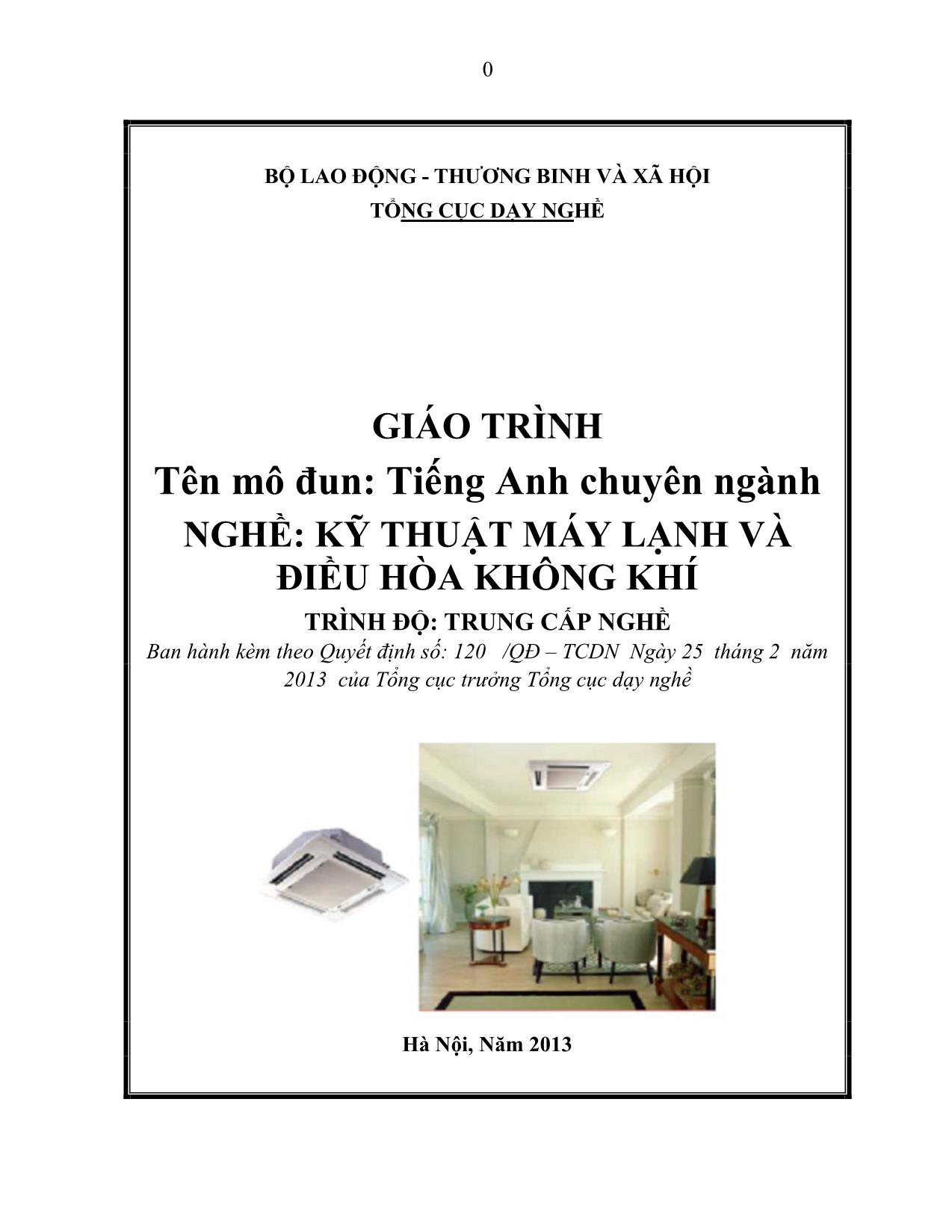
Trang 1
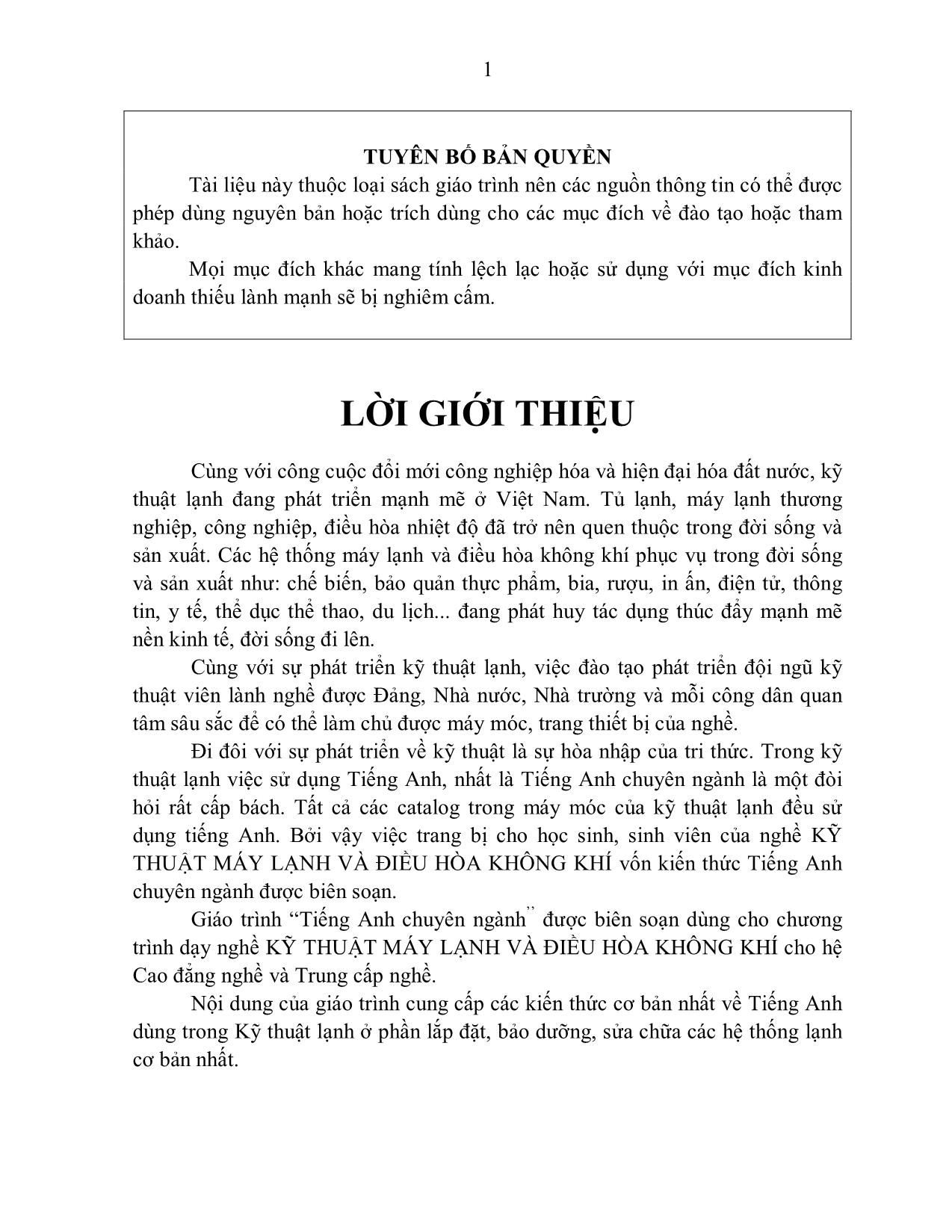
Trang 2
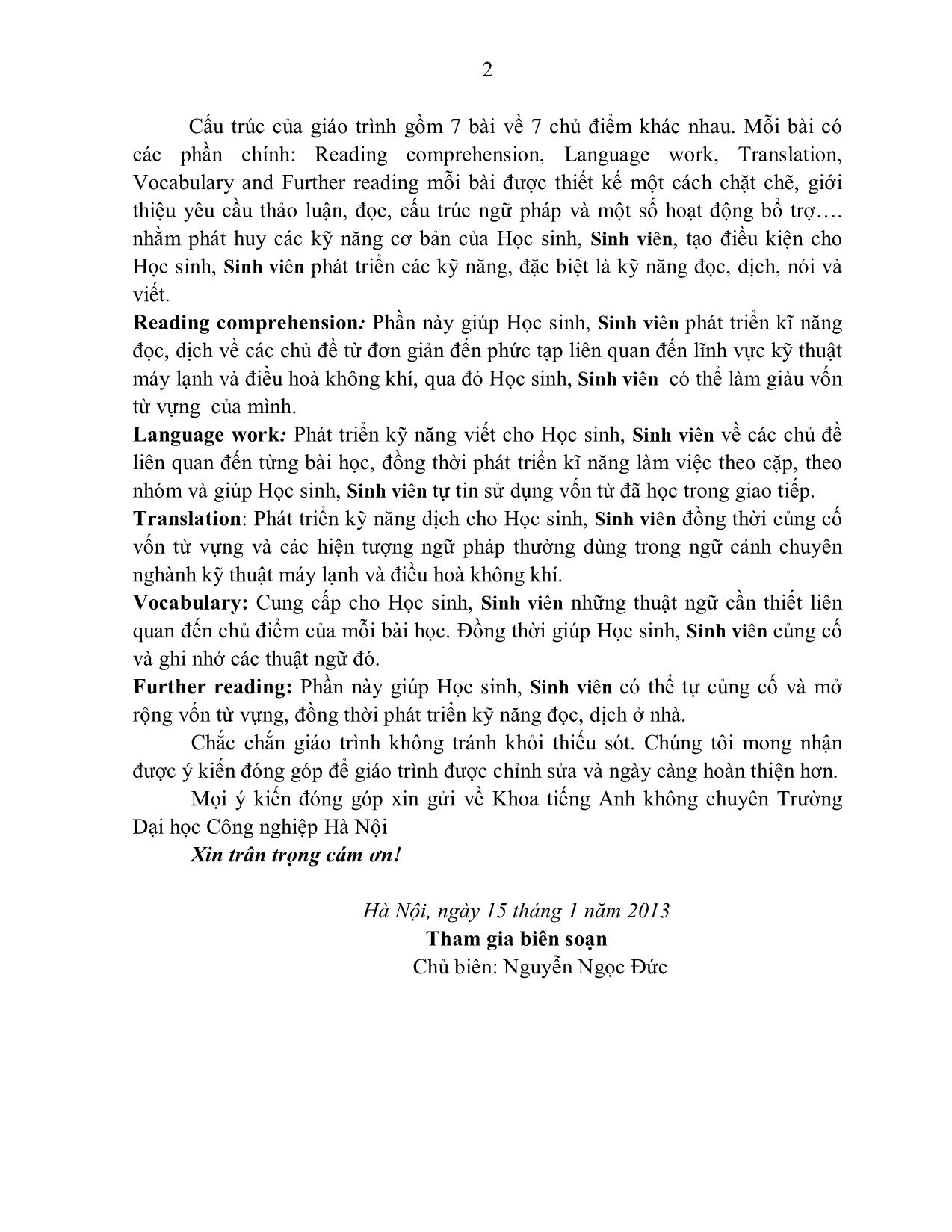
Trang 3
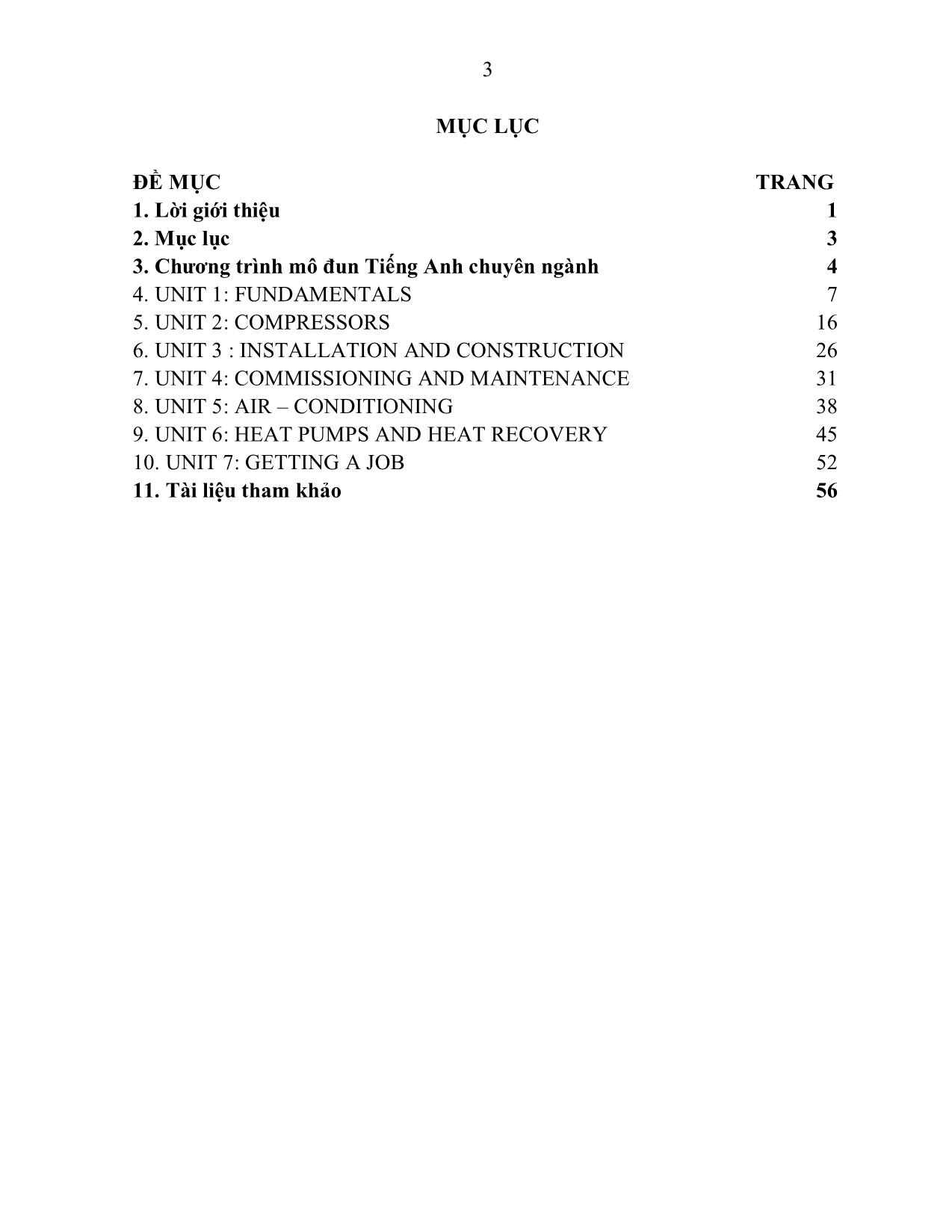
Trang 4
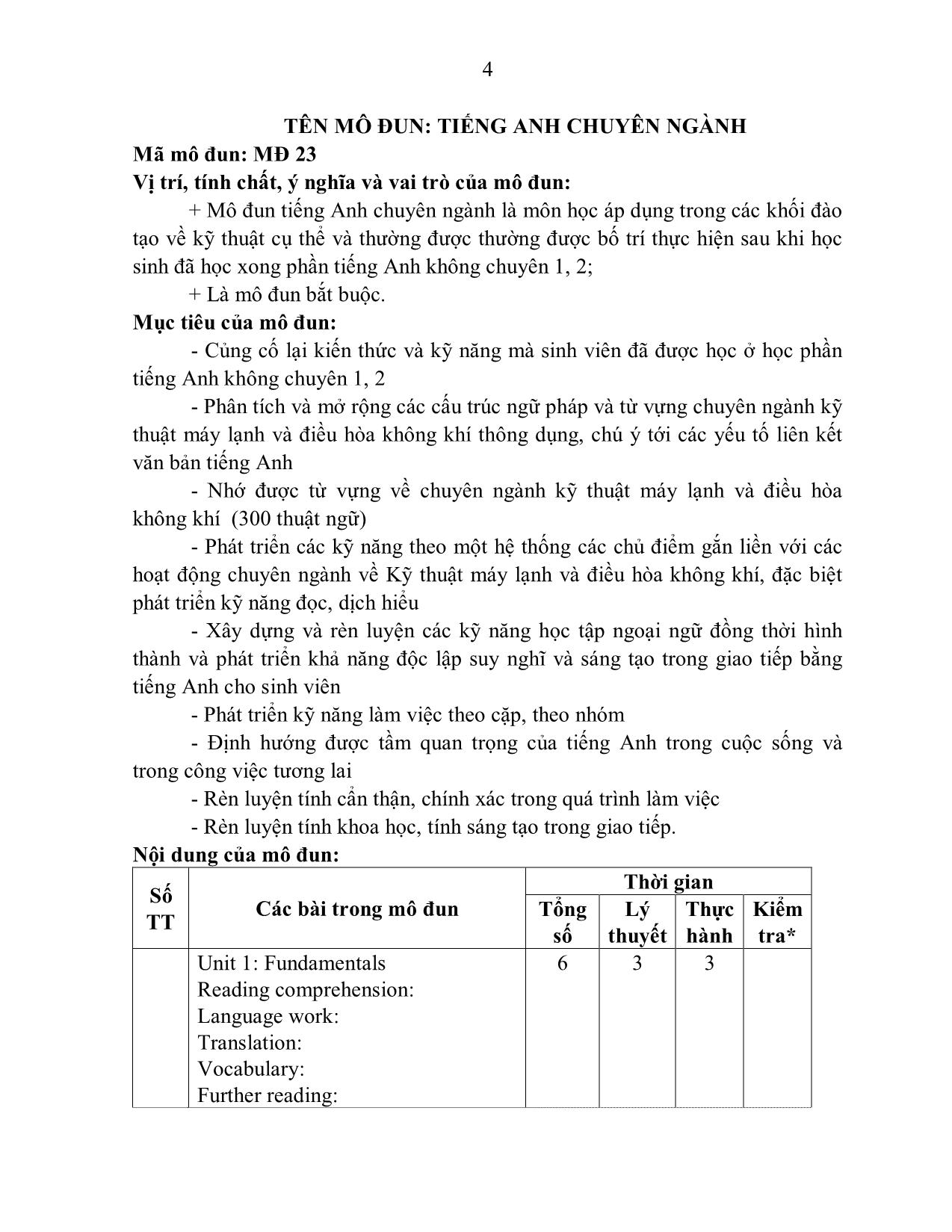
Trang 5
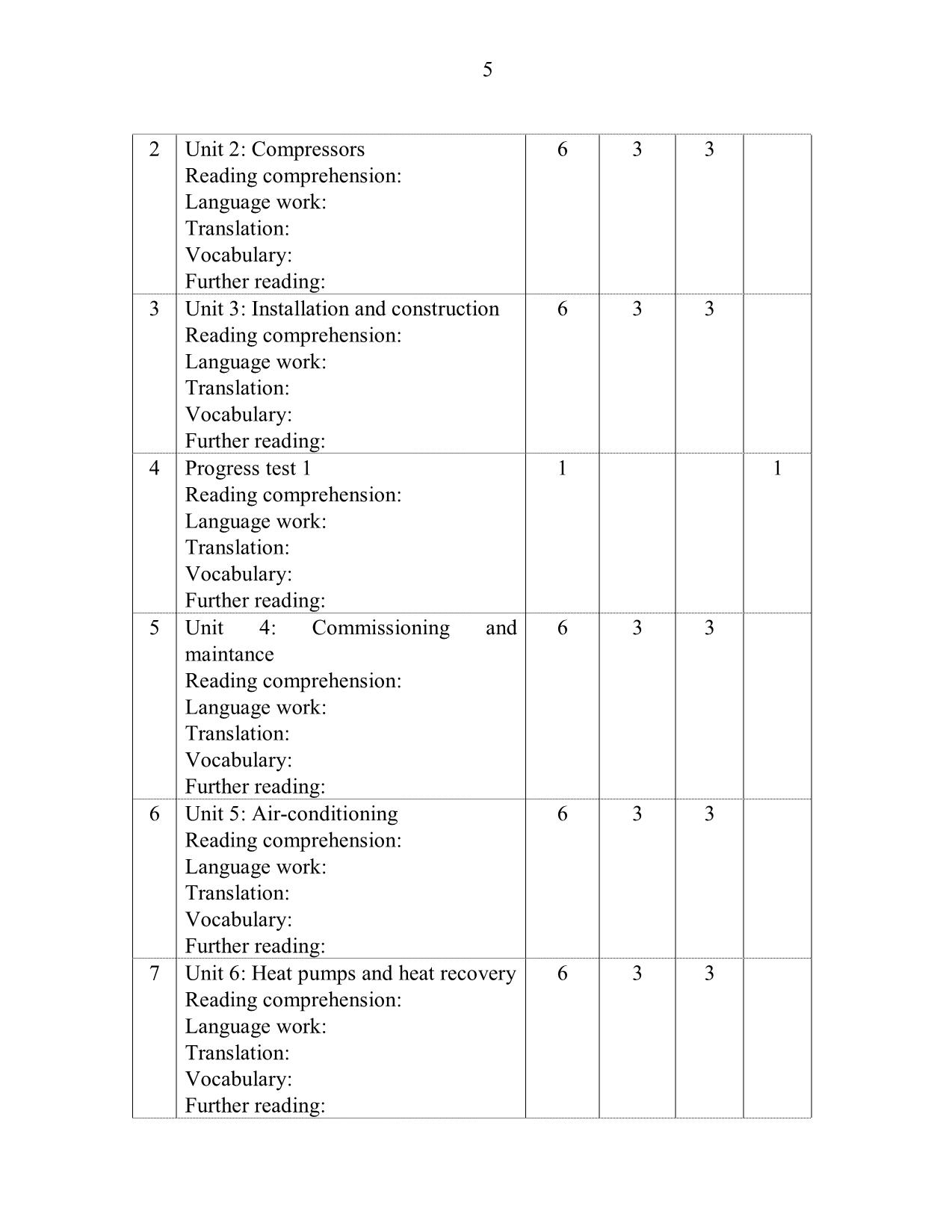
Trang 6
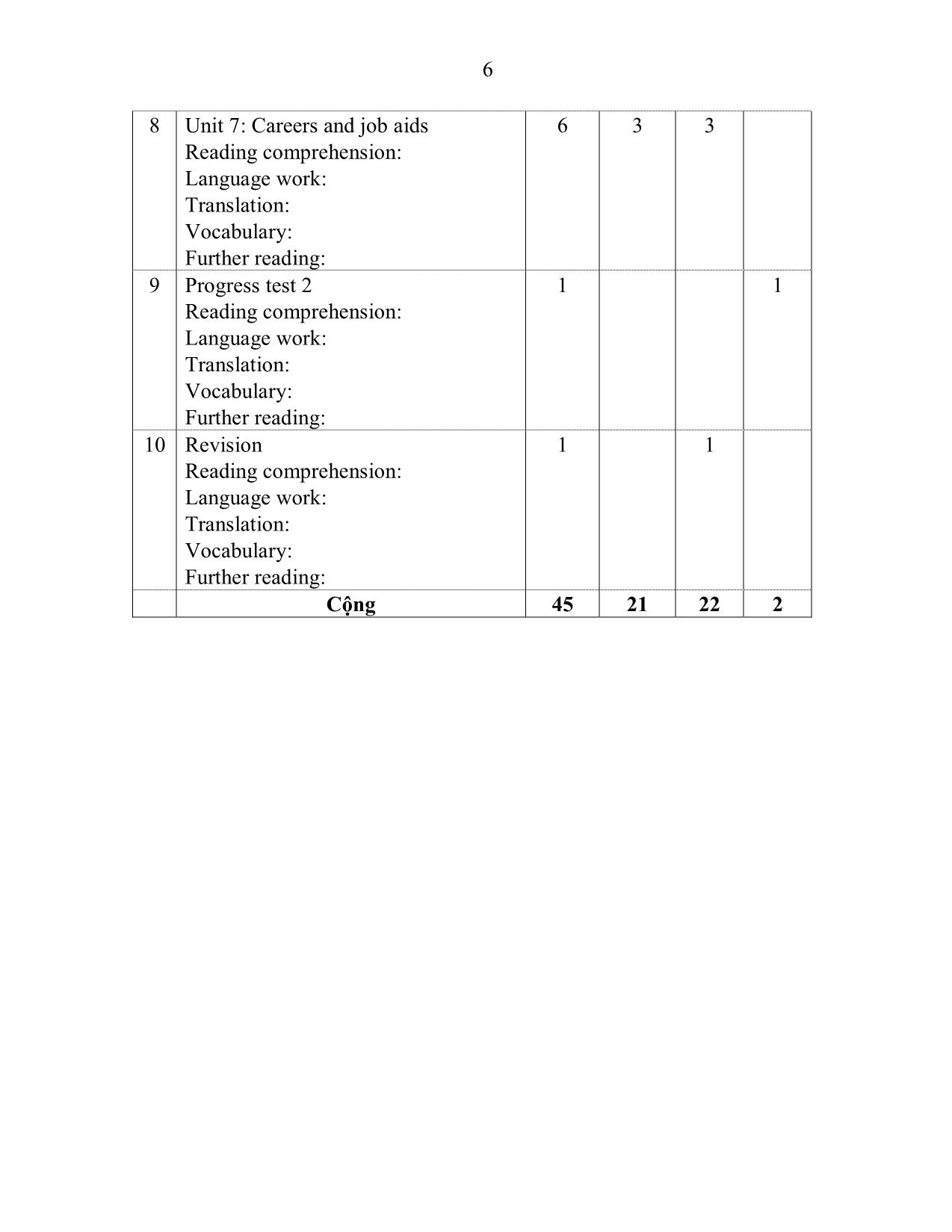
Trang 7
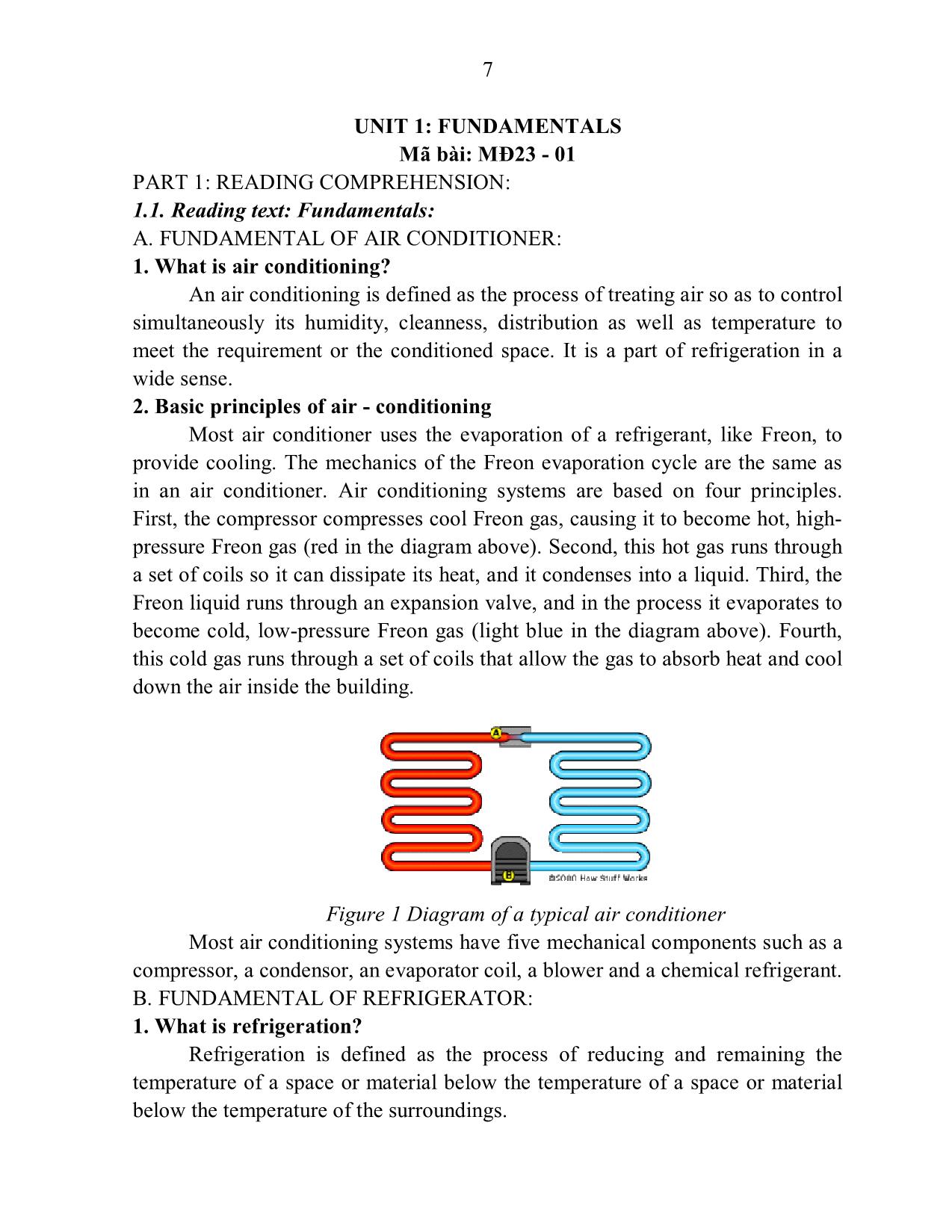
Trang 8

Trang 9
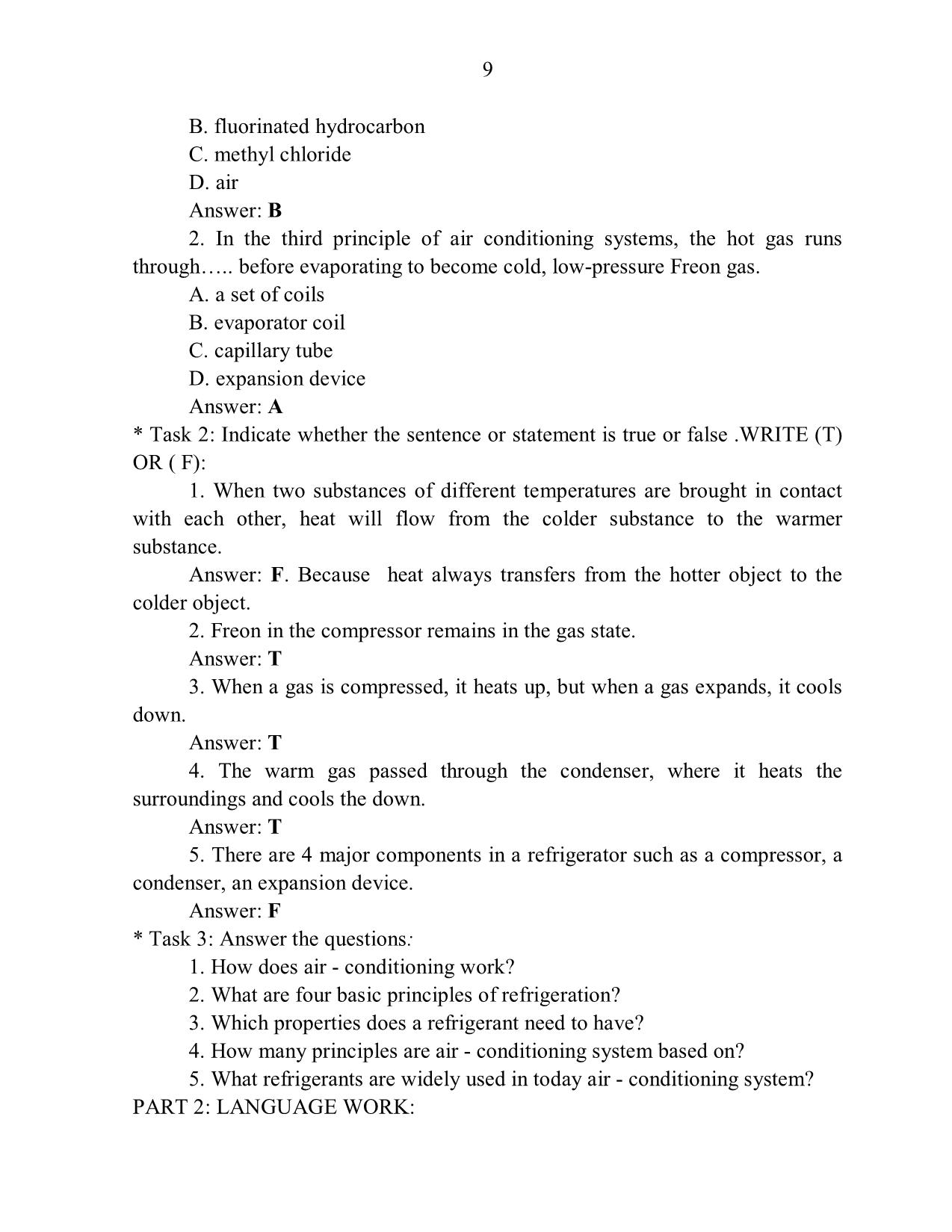
Trang 10
Tải về để xem bản đầy đủ
Tóm tắt nội dung tài liệu: Giáo trình Mô đun Tiếng Anh chuyên ngành - Kỹ thuật máy lạnh và điều hòa không khí
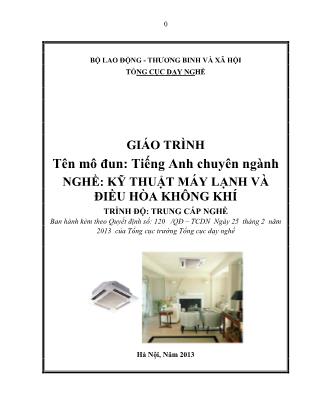
routine cleaning. Central air conditioners should be professionally inspected and adjusted before the beginning of every cooling season. Caution: Before doing any work on an air conditioning system, make sure the power to the system, both to the condenser and to the evaporator assembly, is turned off. 45 UNIT 6: HEAT PUMPS AND HEAT RECOVERY Mã bài: MĐ23 - 06 PART 1: READING COMPREHENSION: 1.1. Reading text: Air - conditioning: Where heat transfer is taking place at the saturation temperature of a fl uid, evaporation or condensation (mass transfer) will occur at the interface, depending on the direction of heat flow. In such cases, the convective heat transfer of the fluid is accompanied by conduction at the surface to or from a thin layer in the liquid state. Since the latent heat and density of fl uids are much greater than the sensible heat and density of the vapour, the rates of heat transfer are considerably higher. The process can be improved by shaping the heat exchanger face (where this is a solid) to improve the drainage of condensate or the escape of bubbles of vapour. The total heat transfer will be the sum of the two components. Rates of two - phase heat transfer depend on properties of the volatile fluid, dimensions of the interface, velocities of fl ow and the extent to which the transfer interface is blanketed by fl uid. The driving force for evaporation or condensation is the difference of vapour pressures at the saturation and interface temperatures. Equations for specific fluids are based on the interpretation of experimental data, as with convective heat transfer. Mass transfer may take place from a mixture of gases, such as the condensation of water from moist air. In this instance, the water vapour has to diffuse through the air, and the rate of mass transfer will depend also on the concentration of vapour in the air. In the air – water vapour mixture, the rate of mass transfer is roughly proportional to the rate of heat transfer at the interface and this simplifi es predictions of the performance of air - conditioning coils. PART 2: LANGUAGE WORK: * Task 1: Cause and effect expression: Study this sentence: Insulation breakdown leads to short circuits: This sentence contains a cause and an effect. We can link a cause and an effect as follow: 46 We can also put the effect first: When a cause has several effects or when an effect has a number of possible causes, we put CAN or MAY before the causative expression. Example: Sparking MAY be caused by worn brushes. Sparking CAN be caused by a worn commutator. Similarly, instead of THE cause/ effect/ result/ consequence of, we write ONE cause/ effect/ result/ consequence of. Example: Worn brushes are ONE cause of sparking. A worn commutator is ONE cause of sparking. Effect Short circuits Cause Insulation breakdown Are caused by result from arise from are the effect of are the result of are the consequence of are due to Cause Insulation breakdown Effect short circuits causes results in produces leads to gives rise to is the cause of 47 Now match these cause and the effect pairs. Then link them using expressions given above. Write 2 sentences for each example, 1 with cause first and the other with effect first. Cause Effect 1 . glare arcing across the points 2 . eddy currents power losses in transformers 3 . excessive heat serious accidents 4 . faulty soldering breakdown of the motor 5 . speaking discomfort to the eyes 6 . failure of a point capacitor damage to semiconductors 7 . exceeding the motor rating bad joints 8 . faulty earth connections interference in receivers * Task 2: Rewrite the following description, using cause and effect expression. (Homework): * Task 3: Describing sequence: Time clause Study this list of events in the manufacture of carbon resistors. overrunning a motor excessive heat insulation breakdown short circuits blown fuses 1 2 3 4 48 We can show that event 2 follow event We can show that event 2 follow event 1 by using sequence word FIRST, THEN. Example: FIRST the resistive element is inserted into the ceramic housing. THEN the ends are sprayed with metal. We can also show the sequence using the time clauses. Example: AFTER THE RRESISTIVE ELEMEMT IS INSERTED IN A CERAMIC HOUSING, the ends are sprayed with metal. BEFORE THE END OF THE ELEMENT ARE SPRAYED WITH METAL, it is inserted into the ceramic housing. The part of each sentence in capitals is a time clause. Time clause can also put last in the sentence. When this happens, there is no comma between the time clause and the rest of the sentence. Example: The ends of the element are sprayed with metal after it is inserted into the ceramic housing. Now write sentences linking these events with time clause using the time word given. 4. The ends of the resistor are sealed. 2. The ends of the element are spayed with metal. 1. The resistive is element is inserted into the ceramic housing. Ceramic element 3. End caps and leads are forced on to the sprayed ends. 4. The ends of the resistor are sealed. 49 * Task 4: Put these events in sequence with the help of the diagram. (Homework): (a) the signal is again amplified (b) the desired signal is fed to the acceptor circuit (c) the signal is amplified (d) the signal is fed to a loudspeaker (e) the signal is mixed with a signal from the oscillator to give a standard intermediate frequency (f) the signal is rectified by the detector. * Task 5: Describing sequence: Reduced time clauses: We can show that event 2 follows event 1 using a time clause: After the cell is sealed, it is cased with a metal skin. The subject of the time clause, the sell, is the same as the subject of the main clause, it. When this happens we can rewrite the time clause using the – ING part of the verb. After being sealed, the cell is cased with a metal skin. Rewrite these sentences by reducing the time clause in all those ones where both subjects are the same. Not all the time clause can be reduced. 1. After the resistors are sorted, they are marked to indicate their values. 2. Before you service an oscilloscope, you should discharge all large electrolytic capacitors. 3. Immediately after the pulse is transmitted, the antenna switch is closed to the receiver. 4. Before the signal is applied to the Y plates, it must be amplified. 5. The signal is amplified after it is rectified. Before the operator signals off, he repeats his call sign. oscillator acceptor circuit mixer intermediate frequency amplifier detector audio amplifier 50 * Task 6: Link pairs of instructions, using reduced time clauses. (Homework): Example: 1. Switch off the main supply. 2. Remove the fuses. → Having switched off the main supply, remove the fuses. 1. Set the controls in the recommended positions. 2. Switch on. 3. Allow a few minutes to warm up. 4. Advance the brightness control until the trace appears. 5. Centralize the trace with the X and Y shift controls. 6. Adjust the focus control for a clear, sharp trace. 7. Switch to the ac input. 8. Connect the input leads. 9. Increase the Y gain control to obtain a convenient size of waveform. 10. Adjust the time base controls to obtain a clear waveform. PART 3: FURTHER READING: Global warming is possibly the most severe environmental issue faced by civilization today. The risk posed by its effects has been described in terms of environmental disaster due to huge future climate changes. Global warming is the increasing of the world’s temperatures, which results in melting of the polar ice caps and rising sea levels. It is caused by the release into the atmosphere of so - called “greenhouse” gases, which form a blanket and refl ect heat back to the earth’s surface, or hold heat in the atmosphere. The most infamous greenhouse gas is carbon dioxide (CO2), which once released remains in the atmosphere for 500 years, so there is a constant build - up as time progresses. The exact extent of the contribution arising from man’s activities may be uncertain, but in any case it is vital to keep it to a minimum and conserve fossil fuel reserves, i.e. minimize greenhouse gas emissions. A major cause of CO2 emission is in the generation of electricity at power stations. The CO2 emission factor (kg of CO2 emitted per kWh of electricity supplied) is dependent on the UK fuel mix for electricity generation. For coal - fi red power stations, the fi gure is relatively high, for gas - fi red stations it is lower and for hydroelectric, wind power or nuclear stations it is zero. Electricity suppliers may claim various mixes of generation type and hence differing emission factors, but the best presently available average UK fi gure is 0.422 kg CO2/kWh (TEWI Guidelines, IOR/BRA). This value is an average of predicted values for 2005 and 2010. It is 51 estimated that refrigeration compressors in the UK consume 12.5 billion kWh per year. The global warming potential (GWP) of a gas may be defi ned as an index comparing the climate impact of its emission to that of emitting the same amount of carbon dioxide. The integrated effect over a fi xed time allows for time decay of the substance. A time horizon of 100 years is usually adopted, although this is much less than the lifetime of CO2 in the atmosphere. The refrigerant only affects global warming if released into the atmosphere. 52 UNIT 7: GETTING A JOB Mã bài: MĐ23 - 07 I. JOB TITLE: Sau khi tốt nghiệp, các bạn có thể xin việc ở cơ quan nhà nước (state company), công ty tư nhân (private company), công ty liên doanh (joint venture), trường học (school) hoặc tự mở doanh nghiệp riêng (self - employed). Dưới đây là một số nghề cụ thể mà các bạn có thể làm trong tương lai. Automation Engineer Electricity Control Engineer Electricity System Engineer Electrical Equipment Engineer Electrical Measure Engineer Electrician 1. Which job do you want to be? 2. Where do you like working? II. READING: Quá trình xin việc bắt đầu từ lúc bạn quan tâm tìm đọc những quảng cáo tuyển dụng trên báo hoặc niêm yết tại trụ sở các văn phòng giới thiệu việc làm, hoặc tại phòng tổ chức của công ty bạn muốn dự tuyển. Bạn cũng có thể tham gia vào các hội trợ việc làm (thường được tổ chức vào dịp các bạn tốt nghiệp ra trường). Dưới đây là một quảng cáo tuyển dụng trên báo (job ad). Hãy đọc và trả lời các câu hỏi dưới đây: 1. What job is it for? 2. Where will the person work? 3. How old is the person? 4. What qualification, experience will the person need? 5. If you are interested in this position, what do you have to do? “Wanted a skilled electrical engineer for a large engineering/electronics company to be built in the industrial complex in Gia Lam - Ha Noi. Candidates must have a good degree in electricity and sufficient practical experience. Minimum age 23 years. Apply stating full particulars regarding, age, experience, salary expected to National Industrial Complex, Gia Lam - Ha Noi within 10 days.” III. WRITING: APPLYING FOR A JOB: 53 1 1 1 Dưới đây là một mẫu thư xin việc cụ thể. Hãy đọc và trả lời các câu hỏi sau đó: 15 Hang Dao Ha Noi,Viet Nam 20 August 2004 The Advertiser, National Industrial Complex Gia Lam, Ha Noi Dear Sir, I am writing to apply for the post of an electrical engineer advertised in “Labour” on the 19 August 2010. I graduated from HAUI in June 2011, with a Diploma in Electrical Engineering. While in college, I did a part-time job as electrician for Rang Dong Lighting Company. Along with it, I was repairing appliances for some households when they required. Concerning my language ability, I am good at English, and currently I am following an English class in the evening language centre. I also have computer skills in Word and Excel. I am hard working, creative and ready to travel away for work if required. A copy of my curriculum vitae is enclosed giving further details and testimonial from HIC relating to my character and proficiency in studies. I hope to hear from you soon, and to be given the opportunity to present myself at an interview. Yours respectfully, Nguyen Thanh Binh 1. How many main parts are there in an application letter? 2. Who write this letter? 3. Who will the letter be sent to? 4. What is the post applied? 5. Underline the sentences or words which can be changed to suit you. 3 2 54 CURRICULUM VITAE Name: Nguyen Thanh Binh Day of birth: 26 May 1980 Address: 15 Hang Dao – Hanoi - Vietnam Telephone: 04 857632 Nationality: Vietnamese Marital status: single Education: 19. to 19..: Tran Phu High School 19. to 20..: Ha Noi Industrial College(Electricity Department) 2000 – present: graduated from HIC Qualification: Degree in electricity, Ha Noi Industrial College C level certificate: English, Computer Extra - curricular: Captain - College Volleyball President - College Union Interests: Music (country folk songs and foreign music) Volleyball, Basketball and Swimming Structure of an application: 1. The address of the writer 2. The date of writing the application 3. The name and address of the employer 4. The salutation 5. The introductory or opening paragraph 6. The body of the application 7. The concluding paragraph 8. The subscription 9. The signature. TASK: Write an application for yourself (Use the letter above as a model ) .. .. 55 .. .. .. .. .. .. .. .. .. .. .. .. .. .. .. .. .. IV. SPEAKING: WORK IN PAIRS: Sau đây là một số câu hỏi thường gặp khi bạn được mời phỏng vấn xin việc. Hai người lập thành một nhóm, hoàn thành các câu hỏi sau. Sau đó, một bạn hỏi, bạn kia trả lời câu hỏi. 1. When / you / leave /college (university)? 2. You / married? 3. Where /you /live? 4. You/tell me / family? 5. You / work / factory? 6. You / speak / foreign language? 7. You / play /sport? 8. You/go / ever /aboard? 9. How much /salary /you / expect? 10. What /your ambition / future? 11. What/your career objectives (mục tiêu nghề nghiệp) 12. You mind/travel/away for work? 56 TÀI LIỆU THAM KHẢO - Fundamentals (latest edition): ASHRAE Handbook. - Refrigeration (latest edition): ASHRAE Handbook. - Principles of Refrigeration: Cambridge University Press – Gosney WB. - The refrigeration scroll compressor and its application: IOR, 1996-7 – Hundy GF and Kulkami S. - Heating, ventilating, air conditioning and refrigeration, 2004: CIBSE Guide B. - Air conditioning Engineering: Butterworth Heinemann, 2000 – Jones WB.
File đính kèm:
 giao_trinh_mo_dun_tieng_anh_chuyen_nganh_ky_thuat_may_lanh_v.pdf
giao_trinh_mo_dun_tieng_anh_chuyen_nganh_ky_thuat_may_lanh_v.pdf

